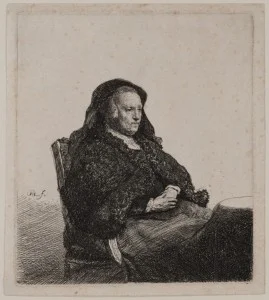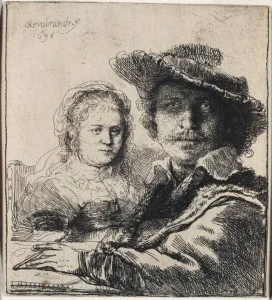Rembrandt's Mid Years
In 1631, Constantijn Huygens (1596 to 1687), a secretary to the Stadholder Frederick Henry, visited Rembrandt’s Leiden studio and commissioned him to paint for the royal court in The Hague. By the end of that year, Rembrandt once again returned to Amsterdam after accepting a commission from a well-known physician in the city. He became an Amsterdam citizen, and later joined the local Guild of St. Luke’s, which was a union that the state required membership to in order for an artist to take on apprentices or to sell paintings to the public.

Portrait of Rembrandt's Mother Seated at a Table, 1631; Art Institute of Chicago
While in Amsterdam, Rembrandt took up residence with Hendrik van Uylenburg, a successful art dealer at the time. There he had met the landlord’s cousin, Saskia van Uylenburgh (1612 to 1642), the daughter of a well-known layer and later the major of Leeuwarden, Friesland. Three years later they married and she was often the model of his paintings, drawings and etchings.

Rembrandt with his Wife, Saskia van Uylenburgh, 1636
All three lived in Hendrik’s house, and by living there, it enhanced Rembrandt’s career and income by introducing him to wealthy patrons who often commissioned portraits, such as Nicolaes Ruts’ portrait that he did in 1631. The many portraits furthered the refinement of his skills in other renditions as well, as seen in The Blinding of Samson, which he created in 1636.

Portrait of Nicolaes Ruts, 1631; Frick Collection, New York
Finally at the age of 33, Rembrandt moved into his own home in Amsterdam, which was a town- house that he purchased in 1639. There he lived for many years and produced many works that are still extremely popular today. He enjoyed great commercial success during this time.

Jacob Blessing the Sons of Joseph (1656, Staatliche Gemäldegalerie, Kassel, Germany)